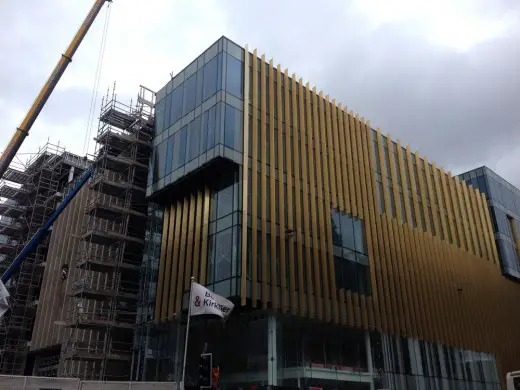Top 10 Architectural gems of Edinburgh, Old and New Architecture in Scotland, Scottish property guide
Top 10 Architectural gems of Edinburgh Guide
Scottish Architecture Studio Article – Scotland Design Firm Interiors
8 Jan 2019
The Old and The New: Top 10 Architectural gems of Edinburgh
Once upon a time, Edinburgh was referred to as the Athens in the North because of its architectural beauty and overall culture. The impressive buildings and cultural heritage remain, but the sobriquet has changed. Nowadays, Edinburghers or Dunediners fondly call their city Auld Reeky or Old Smokey. This somewhat unfortunate name heralds from the Industrial Revolution and the smoky chimneys, none of which are an issue anymore.
In the colder months, the town boasts countless people wrapped in warm jackets, scarves, and caps. The city’s inhabitants crowd past each other and try to defy the wind and cold. The gray clouds in the sky suggest rain showers, but it could clear up in a heartbeat.
Scotland’s capital, Edinburgh, is not known for its friendly climate – and yet, the city is an extremely popular tourist destination. Every year, people from all over the world come here to see the architectural wonders, drink whiskey and just enjoy the ambiance.
The city is brimming with architectural marvels catering to any taste. You can find buildings of gothic design to the somewhat controversial Scottish Parliament Buildings, which have a more modern smack. Whatever happens, this city of the north truly inspires and lives up to its name as the Athens of the North.
Edinburgh Castle – One of Edinburgh’s oldest and most impressive architectural gems
Edinburgh Castle towers above the city’s other buildings on the top of Castle Rock, the plug of an extinct volcano. It remains unclear when the first stone for the castle was laid. However, historians believe that construction on the gray stone behemoth begun in the 7th century.
Mary Queen of Scots, known as Mary Stuart, was the most famous resident of the castle. Mary and her husband Lord Darnley lived in the castle. The shocking death of Mary’s Catholic private secretary, David Rizzio, who many thought was the father of her child, inspired works of art from the likes of John Opie. Lord Darnley was jealous of Mary’s relationship with David Rizzio. On 9 March, a group of the conspirators, accompanied by Darnley, murdered Rizzio in front of the pregnant Mary at a dinner party in Holyrood Palace.
Princess Street Gardens, one of the city’s most popular venues, lies at the foot of Edinburgh Castle. Above the castle’s gatehouse, flanked by statues of William Wallace and Robert the Bruce, lies the building’s impressive Half Moon Battery. Edinburgh Castle is a bastion of strength and the key landmark of the city.
The Palace of Holyroodhouse – Royal Residence at the bottom of Arthur’s Seat
The Palace of Holyroodhouse is the Queen of England’s royal residence in Scotland. The building marks the eastern end of the Royal Mile and is undoubtedly one of Edinburgh’s most important and beautiful buildings. In short, it’s an architectural delight.
Holyrood Palace is a closed four-wing complex with a square floor plan. The oldest part is the northwest tower, which was begun under James IV and completed in 1532 under his successor James V. Its counterpart, at the southwestern corner of the castle district, is much younger and was created in its present form only between 1824 and 1834 to plans by Robert Reid, who wanted to make the palace symmetrical.
The palace’s main portal is flanked on either side by coupled Doric columns depicting the Royal Scottish coat of arms. The portal is crowned by an octagonal, lantern-like attachment, the outside of which carries a dial. It concludes in a crown. After passing through the entrance, the visitor stands in the main courtyard of the palace – then let the exploring begin.
The Scottish National Gallery – Neo-classical majesty
The ornate Classicist building designed in imitation of a Greek temple stands next to the Royal Scottish Academy Building on ‘The Mound’ between the two parts of Princes Street Gardens.
Designed by William Henry Playfair, the building has been used as a museum since its completion. The museum was opened in 1859. Like the Royal Scottish Academy Building, William Thomas Oldrieve remodeled it in 1912. Since the reopening, the focus has been on building a permanent national collection of Scottish and European art.
The structure with two entrances atop stylobate steps blends into the outstanding backdrop of the city’s main thoroughfare. The building with Ionic columns and tetrastyle porticos truly is a marvel, especially when considering Henry Playfair’s limited budget at the time.
The Scottish Parliament Building – A postmodern stunner
The Parliament Building is located on the Royal Mile in Edinburgh’s Old Town, opposite the Royal Palace at Holyrood. Scotland wished the building to have a structure with a distinctive Scottish character. Whether this was achieved depends on the eye of the beholder.
The architects drew their inspiration for the design from the surrounding landscape and the flower paintings of the Scottish architect and designer Charles Rennie Mackintosh.
The construction cost of the house multiplied from the originally planned 40 million pounds to a staggering 431 million. The official opening by the Queen took place in October 2004.
St. Giles Cathedral – Edinburgh’s most important church, tells many stories and enchants with its beauty.
St Giles Cathedral is located on the Royal Mile about halfway between Edinburgh Castle and Hollyrood Palace. When you approach this place of God from the front, the church tower in the shape of a crown first appears – today, a landmark of the Edinburgh skyline.
You step into this House of God through an ornate gate with many statuettes. The moment you enter, you will be bedazzled by the nave of the church that opens up before you with the sanctuary and the communion table in the middle. The length of the structure concludes with the choir and a large stained-glass window.
If you go further down the aisle, you pass the Holy Blood Aisle. The small chapel commemorates the half-brother of Mary Stuart, James Stewart. And when the Earl of Moray was assassinated in 1570, the famous Scottish reformer, John Knox, held the memorial service. This service commemorating the Scottish aristocrat’s death is immortalized in the lower part of the stained glass window.
Circus Lane – A genuinely picturesque mews in the center of Edinburgh
This narrow street once contained the coach houses serving the more prestigious residences nearby. Today, this central but secret spot has taken on its own character. For one, it is a number one destination for any serious travel instagramer, and secondly, the mews houses are some of the city’s most expensive properties.
One could describe this narrow cobbled way as quaint and is at its most beautiful in the spring when the flowers are in full blossom. Located at the edge of the New Town, you’ll be surprised not to find many tourists roaming the cobbles. It’s perfect to get an authentic idea of what it was like to live in eighteenth-century Edinburgh.
The General Register House – A truly grand building
Robert Adam built the first purpose-built archive in Britain in the late 18th century and completed it in the early 19th century. The building houses many of Scotland’s most important historical records, including early government documents, church records, land registers, and political writings, and private collections.
This grand public building has a neo-classical frontage and along with the Scottish National Gallery is one of the reasons why Edinburgh was referred to as the Athens of the North.
The structure is of solid stone with brick vaults with impressive flagstones adoring the floors. In its time, the building was considered state-of-the-art with the heated flooring and specially incorporated rooms to guarantee the safety of the archives. However, what gets most visitors is the extraordinary rotunda, which is a stunning room with an imposing domed roof, rising above the entire building.
Calton Hill – A majestic view with the largest amalgamation of architectural gems in the city
When the sun sets in the west of Edinburgh, Calton Hill offers an incomparable view. But there is a lot more to discover up there.
Calton Hill has a long history, starting off as an independent community lying at the foot of the hill. Later, there was a notorious prison there. Today, the house of the Scottish Government is at the bottom of the hill. But most interesting are the monuments and buildings at the top of the hill. Dating back to the 18th and 19th centuries, when the New Town of Edinburgh emerged, these edifices recall important events in Scottish history.
Old City Observatory
The Old City Observatory probably occupies the most extensive area on Calton Hill. The middle building is reminiscent of a Greek temple. That’s no wonder, as it was William Henry Playfair who designed it.
In 1818, the observatory, with the dome with the copper roof containing the telescope, went into operation. Close by you will find the Thomas Short Observatory, which was built in the mid-18th century – its Gothic style stands in stark contrast to the other more ancient-looking monuments on Calton Hill.
The Nelson Monument – In honor of a hero of Britain
The Nelson Monument was completed in 1816 and commemorates Vice-Admiral Horatio Nelson’s victory of the Battle of Trafalgar. The tower stands on top of Calton Hill and rises another 32 meters. Interesting is the time ball installed by the 1852 astronomer Professor Charles Piazzi Smyth.
In the olden days, at one o’clock in the afternoon, a clock triggered the ball’s holding mechanism via an electric wire, which then dropped. The sailors could see it in the harbor of Leith and set their watches accordingly. Only later did the famous one-o’clock-gun arrive at the Edinburgh Castle as an acoustic signal.
And lastly Nuttfield Transplantation Surgery Unit, Western General Hospital
If you are inclined toward more contemporary and, somehow, quirky, or, maybe utilitarian designs, this is the one for you.
Peter Womersley was the brainchild behind the Nuttfield Transplantation Surgery that is a clear statement of Brutalist architecture. He is considered one of Scotland’s greatest architects since Macintosh. If you place yourself in the right spot, you will surely be able to take a great photograph of one of the capitals most iconic buildings that not many people know about.
Edinburgh Architecture
Courtyard by Marriott Edinburgh City Centre Hotel
Edinburgh Georgian Townhouse Apartment
Glamorous Edinburgh West End Apartment
Mezzanine Apartment in Edinburgh
3-8 St Andrew Square
Design: CDA and Gareth Hoskins Architects

photo © Adrian Welch
St Andrew Square Building
Comments / photos for the The Old and The New: Top 10 Architectural gems of Edinburgh page welcome

